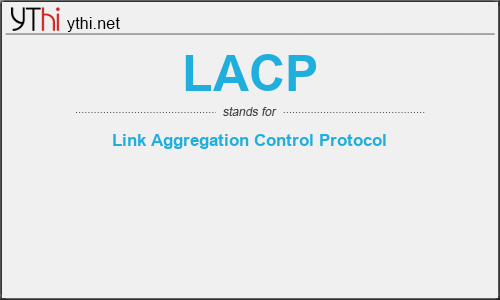What does LACP mean? What is the full form of LACP?
The Full Form of LACP is Link Aggregation Control Protocol.
LACP, a subcomponent of IEEE 802.3ad, provides additional functionality for link aggregation groups (LAGs). Use the link aggregation feature to aggregate one or more Ethernet interfaces to form a logical point-to-point link, known as a LAG, virtual link, or bundle. The MAC client can treat this virtual link like a single link.
Starting in Junos OS Release 15.1X49-D80, Link Aggregation Control Protocol (LACP) is supported in Layer 2 transparent mode in addition to existing support in Layer 3 mode for SRX300, SRX320, SRX340, SRX345, SRX1500, SRX4100, SRX4200 devices and vSRX instances. Starting in Junos OS Release 15.1X49-D40 and Junos OS Release 17.3R1, Link Aggregation Control Protocol (LACP) is supported in Layer 2 transparent mode in addition to existing support in Layer 3 mode for SRX5400, SRX5600 and SRX5800 devices. When the SRX Series device uses LACP to bundle the member links, it creates high-speed connections, also known as fat pipe, with peer systems. Bandwidth can be increased by adding member links. Increased bandwidth is important especially for redundant Ethernet (reth) and aggregated Ethernet (ae) interfaces, for transmitting and receiving packets to and from the peer end for the whole system. LACP also provides automatic determination, configuration, and monitoring member links. LACP is compatible with other peers that run the 802.3ad LACP protocol. It automatically binds the member links without manually configuring the LAG, thereby avoiding errors.
Link Aggregation Benefits
Link aggregation increases bandwidth, provides graceful degradation as failure occurs, and increases availability. It provides network redundancy by load-balancing traffic across all available links. If one of the links fails, the system automatically load-balances traffic across all remaining links.
When LACP is not enabled, a local LAG might attempt to transmit packets to a remote single interface, which causes the communication to fail. When LACP is enabled, a local LAG cannot transmit packets unless a LAG with LACP is also configured on the remote end of the link.
A typical LAG deployment includes aggregate trunk links between an access switch and a distribution switch or customer edge (CE) device.
LACP
means
Link Aggregation Control Protocol![]()
Translate Link Aggregation Control Protocol to other language.


Leave a Reply
You must be logged in to post a comment.